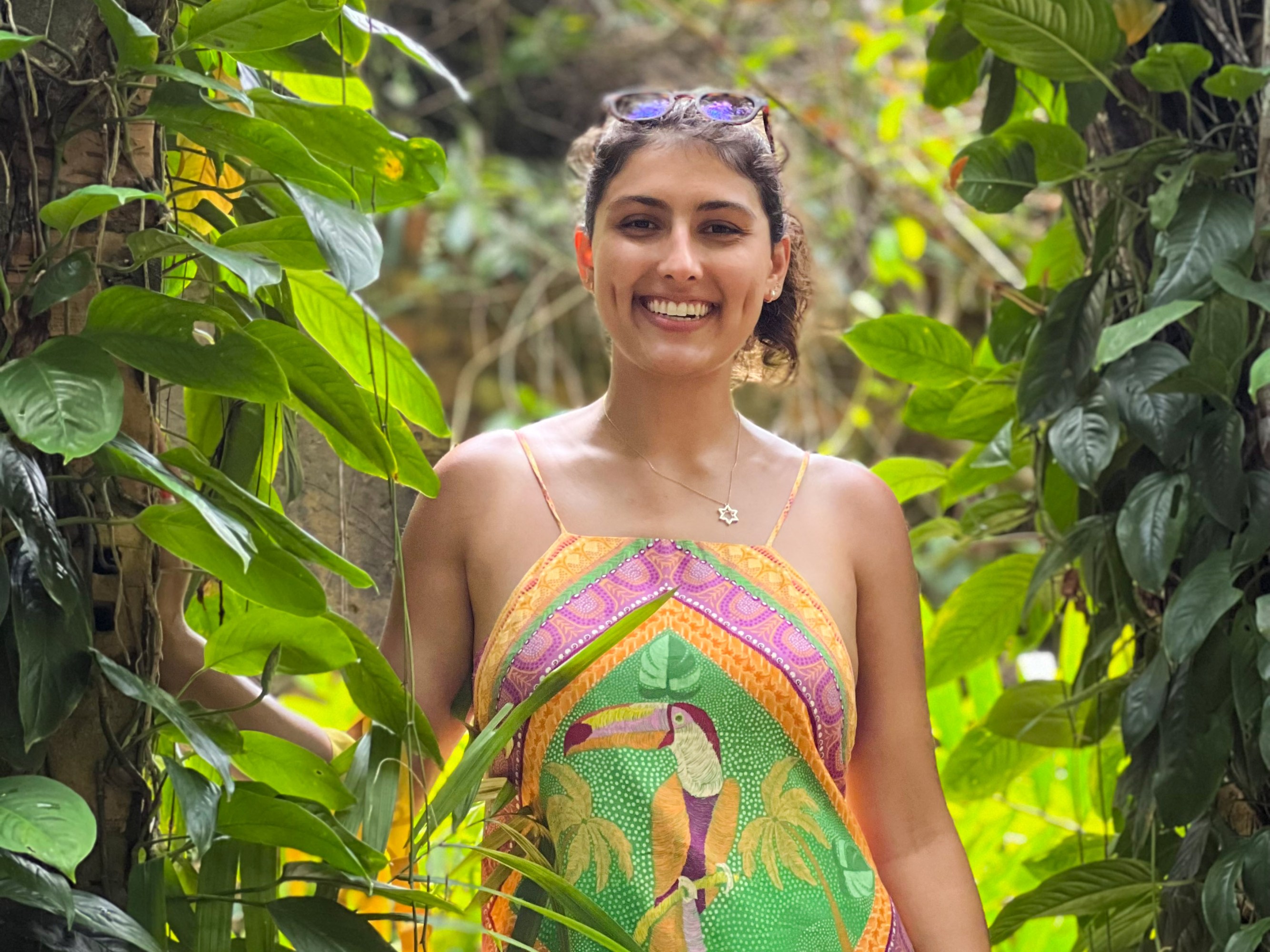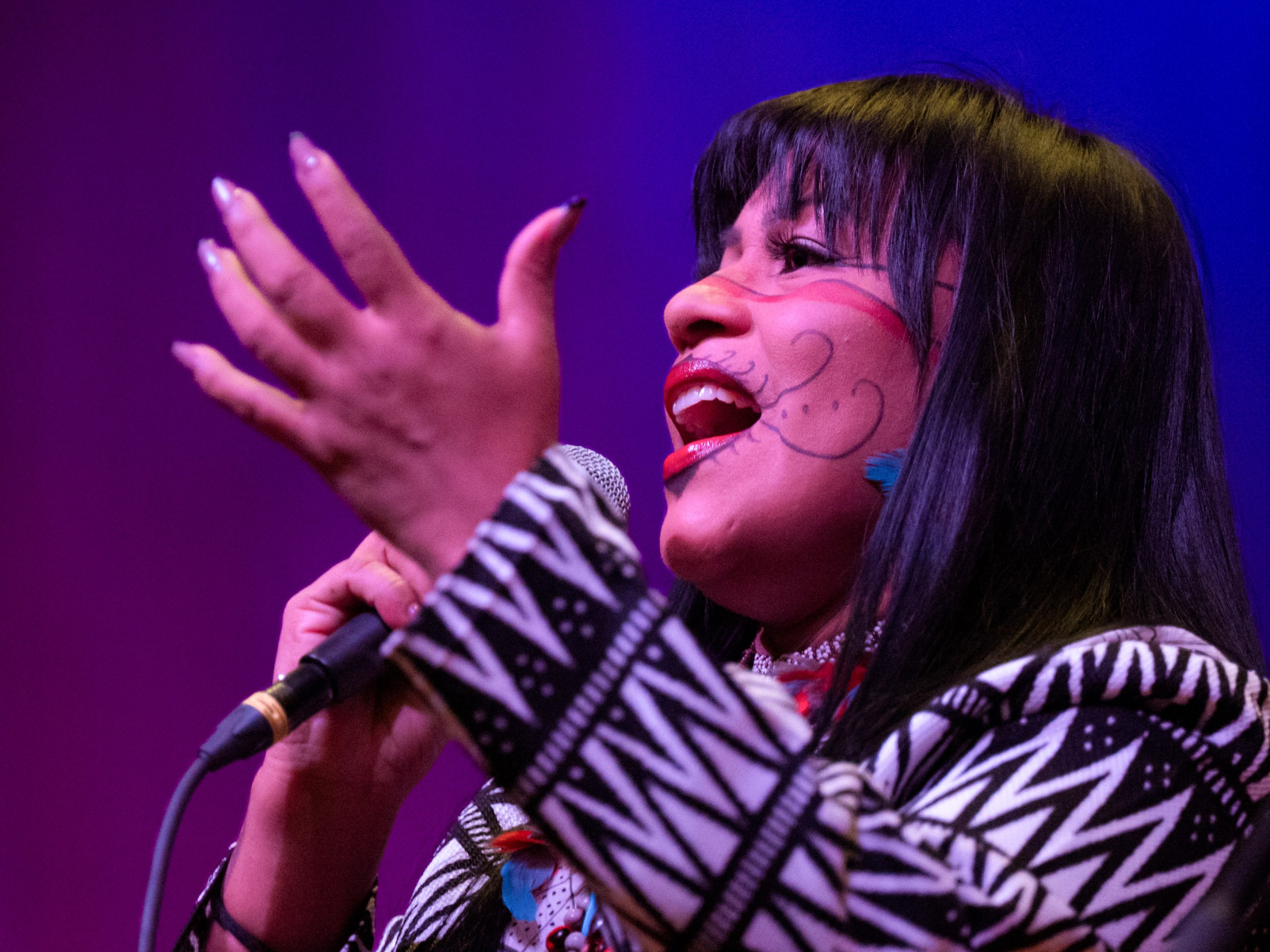Learning and listening in Amazonia
We had just sat down to lunch with Dona Dada, an Indigenous Brazilian artisan, at her family farm in Sao Gabriel da Cachoeira. It was April of 2022, and my research colleagues and I were visiting to learn how she collects and processes plant fibers for use in her crafts. Before us were traditional foods that I was familiar with, including tambaqui fish and beiju de tapioca, a large, crunchy tapioca crepe cooked in a traditional clay oven. But I was intrigued by a bowl of what appeared to be a dark-brown lumpy sauce and asked what it was. Sauvas," replied Dona Dada. My friend Samy began laughing hysterically. Looking closer, I saw hundreds of fat, juicy ants floating in a bowl of broth and green onions. Dona Dada grabbed one and popped it in her mouth. I heard the crunch.
Although I'd never expected to dine on its bugs, the Amazon rainforest has always captivated my imagination with its lush landscapes, its rich biodiversity, and the profound wisdom of its Indigenous peoples. I was also drawn to this ecological wonder by my interest in applying materials science in a unique way to address issues related to sustainability and climate change. So I was excited to be able to venture into the Brazilian Amazon for the first time in the summer of 2019 through the MIT International Science and Technology Initiatives (MISTI) program. My desire was not just to do another internship; I wanted to understand the intersection of traditional knowledge and modern science to help solve the problems facing our world. And when I researched natural botanical resins in Santarem, a town in the Brazilian state of Para, I developed an appreciation for the interconnectedness of Indigenous culture, materials, and music.
In the town of Alter do Chao, where my professor lived, traditional Paraense carimbo music dominated everyone's social lives. As an undergraduate who was double-majoring in music, I decided to join the town's major carimbo group, Grupo Cobra Grande. Despite my rudimentary grasp of Portuguese, I knew that I could communicate with the group through music. With the help of offline Google Translate and charades, I managed to learn not only the intricate rhythms and dance moves involved in this traditional musical style, but also the meanings of the lyrics and the associated folklore. We began every rehearsal and performance with a song calling the mythical frog Muiraquita into the Lago Verde lake to protect the town and the people from evil spirits. The dance moves in carimbo reflect stories about the famous Amazonian pink dolphin coming to land in the evenings to court young women-men wear hats to cover their dolphin spouts and dance in circles around the women like dolphins jumping in and out of the water.
 Talia Khan '20 in theabandoned city of Velho Airao before she learned that killer ants haddriven its people away. Her friend had an allergic reaction when bitten, but luckily, Khan had an EpiPen.COURTESY OF THE AUTHOR
Talia Khan '20 in theabandoned city of Velho Airao before she learned that killer ants haddriven its people away. Her friend had an allergic reaction when bitten, but luckily, Khan had an EpiPen.COURTESY OF THE AUTHORI was lucky enough to return to Brazil two years later as a Fulbright scholar in Manaus, Amazonas, where I got to study natural rainforest materials such as curaua fibers and Marasmius yanomami fungi in the lab, research their traditional uses in artisanal crafts, and explore their potential as sustainable structural materials. I also volunteered at the Nobre Academia de Robotica, an organization that gives children from impoverished backgrounds, including Indigenous youths from the Sao Sebastiao community, free access to education in coding, science, and technology. They learn to use drones for land surveillance and develop sensors to monitor environmental conditions, honoring their cultural legacy and extending it with technological capabilities.
When I met a local clarinetist named Abner at the Manaus synagogue, he invited me to watch as he recorded music with Eliberto Barroncas, an art professor at a local university who played instruments he crafted from repurposed found" objects such as cardboard tubes, rubber tires, and marbles. As Abner played the clarinet, Barroncas created a background that immersed the listener in the sounds of Amazonia: croaking frogs, flowing water, shaking leaves. Afterward, we discussed the interconnectedness of nature and music over coffee. Barroncas's philosophy is that making music should come from the soul, as a tangible expression of one's natural surroundings. This idea resonated with me, inspiring me to deepen the scope of my extracurricular research on eco-organology-the study of how instruments are connected to the natural world. I shared several of his quotes when I presented my research at the American Musicological Society annual conference in the fall of 2022.
Through my work with the Nobre Academia de Robotica, I also met the local music producer and arranger Cesar Lima, who developed a virtual-reality app called The Roots VR" to introduce users to over 100 Amazonian instruments. This app allows users to interact with a variety of these instruments in virtual settings, creating an accessible way for people worldwide to engage with and appreciate the rich musical heritage of the Amazon. His work demonstrates how modern technology can be harnessed to preserve and promote musical traditions.
I told Fred that everyone needed to come to the Amazon. Everyone needed to taste the tingling jambu flower, drink suco de tapereba, and perform in the famous Teatro Amazonas opera house."
I found myself sharing stories of these incredible people with my music friends at MIT and with Fred Harris, director of the MIT Festival Jazz Band, a group I joined as an undergrad. I told Fred that everyone needed to come to the Amazon. Everyone needed to taste the tingling jambu flower, drink suco de tapereba, and perform in the famous Teatro Amazonas opera house. We had to not just introduce other students to the music of the Amazon, but take them there so they, too, could collaborate with Indigenous performers. In the spring of 2023, Fred brought some 80 MIT student musicians, none of whom spoke Portuguese, to the Rio Negro in the middle of the Amazon rainforest. These students, along with approximately 20 staff, faculty, and guest artists, communicated with the locals through science and music.
The project Fred led, called Hearing Amazonia," was a testament to the power of interdisciplinary collaboration. Influenced by my experiences in the Amazon, and further inspired by guest artists Luciana Souza, Anat Cohen, and Djuena Tikuna, it culminated in a concert featuring Brazilian and Amazonian music influenced by the natural world. Working together, we created a musical narrative of the Amazon's beauty and the looming threats it faces. We went on to perform it both at MIT and in the Amazon.
 Fred Harris, senior lecturer in music and director of wind and jazzensembles at MIT, gets a traditional pattern painted on his face withnatural plant dye by a woman in the Sao Sebastiao community.MIT VIDEO PRODUCTIONS
Fred Harris, senior lecturer in music and director of wind and jazzensembles at MIT, gets a traditional pattern painted on his face withnatural plant dye by a woman in the Sao Sebastiao community.MIT VIDEO PRODUCTIONSThis project transcended the traditional boundaries between education and activism. Bringing MIT student musicians to the Amazon provided a platform for experiential learning unlike any other. It wasn't just about playing music; it was about understanding music as a living entity, deeply entwined with the environment where it originates.
In planning the trip, we knew that engaging with the Indigenous communities was essential. We partnered with the Nobre Academia de Robotica to visit the Sao Sebastiao community so the whole group could learn about their culture, their traditions, and the ways in which science and tech are helping them protect their land and maintain their fishing economy. We also took part in workshops with Cesar Lima and Eliberto Barroncas. The opportunity for students to play Professor Barroncas's instruments and take part in an impromptu jam session was a powerful demonstration of music as a universal language, transcending barriers and connecting us to the environment and each other. He and Lima influenced us beyond the realm of music, offering insights into the broader implications of cultural sustainability and environmental stewardship. Their work demonstrated that the preservation of cultural practices and natural ecosystems is not only an artistic or environmental issue but also a matter of global responsibility.
 Djuena Tikuna, the first Brazilian musician to perform in Kresge, singsat the We Are the Forest" concert.GRETCHEN ERTL
Djuena Tikuna, the first Brazilian musician to perform in Kresge, singsat the We Are the Forest" concert.GRETCHEN ERTLAfter getting to spend time with the people of Manaus and play with local musicians including Barroncas and the Amazonas State Jazz Band, we capped off our trip with a final concert featuring the Indigenous singer Djuena Tikuna at Teatro Amazonas. The event was a celebration of cultural and ecological diversity, and our collaborative performance of Nos Somos a Floresta" (We Are the Forest) and Eware" (Sacred Land) reminded us of our shared responsibility for our planet and the importance of empowering Indigenous people, who are the stewards of their land. When we got back to MIT, it was an incredible experience to share all of this in a concert called We Are the Forest-Music of Resilience and Activism." Tikuna became the first Indigenous Brazilian musician to perform in Kresge Auditorium-and we were given the opportunity to use music to communicate the urgency of environmental and Indigenous activism to a broader audience.
This documentary follows the MIT musicians who traveled to the Brazilian Amazon for a cultural and scientific exchange and features performances both in Brazil and at MIT.The Hearing Amazonia project is more than a series of events; it's a movement. It's about instilling a sense of responsibility and empathy for our environment, and understanding that the fight to preserve the Amazon requires preserving our global heritage along with biodiversity. My hope is that this project serves as a blueprint for future endeavors aiming to harmonize human development with environmental sustainability, ensuring the preservation of both cultural heritage and natural ecosystems for generations to come.
Talia Khan '20, a vocalist who double-majored in materials science and engineering and music, is currently a graduate student in mechanical engineering.